Our Summary
The research paper discusses a case of prostatic carcinosarcoma, a rare and aggressive type of tumor that affects the prostate and can spread to other parts of the body. The patient had a large tumor in his pelvis as well as a tumor in his lung. Doctors tried to treat him with surgery and chemotherapy, but the cancer continued to grow and spread to his bones. The usual treatments for prostate cancer were ineffective. The patient survived for 18 months after his diagnosis. The paper concludes that prostatic carcinosarcoma is extremely aggressive and difficult to treat.
FAQs
- What is prostatic carcinosarcoma and how common is it?
- What are the common treatments for prostatic carcinosarcoma and why were they ineffective in this case?
- What was the patient’s life expectancy after being diagnosed with prostatic carcinosarcoma?
Doctor’s Tip
A doctor might tell a patient with a ureterostomy to make sure to keep the stoma clean and dry to prevent skin irritation or infection. It is also important to drink plenty of fluids to stay hydrated and help prevent kidney stones from forming. Additionally, patients should follow their doctor’s recommendations for diet and medication to help manage any symptoms or complications associated with the ureterostomy. Regular check-ups with a healthcare provider are also important to monitor the stoma and overall health.
Suitable For
Patients with ureterostomy are typically those who have blockages or obstructions in their ureters, which are the tubes that carry urine from the kidneys to the bladder. This can be caused by conditions such as kidney stones, tumors, or scar tissue. Ureterostomy may also be recommended for patients who have had a urinary diversion surgery, where the normal flow of urine is rerouted due to conditions such as bladder cancer or pelvic surgery. Additionally, patients who are unable to urinate normally due to neurological conditions or spinal cord injuries may also be candidates for ureterostomy.
Timeline
Before ureterostomy: The patient likely experienced symptoms such as difficulty urinating, blood in the urine, pelvic pain, and possibly bone pain if the cancer had spread. The patient would have undergone various tests such as biopsies, imaging scans, and blood tests to diagnose the cancer and determine the extent of the disease. Treatment options such as surgery, chemotherapy, and radiation therapy may have been considered before deciding on ureterostomy.
After ureterostomy: Following the ureterostomy surgery, the patient would have a stoma on their abdomen where urine is diverted from the kidneys to a bag outside the body. The patient would need to learn how to care for the stoma, empty and change the urine bag, and manage any complications that may arise. The patient may also need to adjust to the physical and emotional changes associated with having a stoma. Follow-up appointments with healthcare providers would be necessary to monitor the patient’s recovery and overall health.
What to Ask Your Doctor
- What is a ureterostomy and why is it necessary in my case?
- What are the potential risks and complications associated with a ureterostomy procedure?
- How will a ureterostomy affect my daily life and activities?
- Will I need any special care or follow-up appointments after the procedure?
- Are there any dietary or lifestyle changes I should make to support my recovery after a ureterostomy?
- What are the long-term implications of having a ureterostomy?
- Are there any alternative treatment options for my condition besides a ureterostomy?
- What is the success rate of a ureterostomy in patients with similar conditions to mine?
- How will a ureterostomy impact my urinary function and overall quality of life?
- Are there any support groups or resources available for patients undergoing a ureterostomy procedure?
Reference
Authors: Garde García H, Hernando Arteche A, Useros Rodríguez E, López Galán C, Paños Fagundo E, García Murga JC. Journal: Arch Esp Urol. 2018 Sep;71(7):614-617. PMID: 30198853
